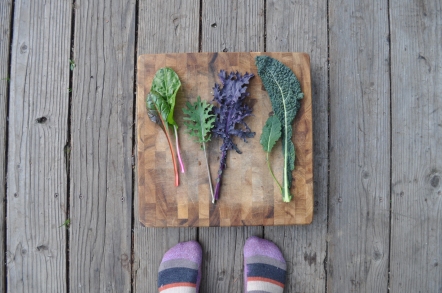
I realize this post title might evoke images of MacGyver defusing a bomb with a freshly chewed stick of wintergreen gum. I’m talking about the other winter greens—you know, Swiss chard, kale, and leafy vegetables in that vein.
Mike and I had our first interlude with winter greens several years ago. In a zealous attempt to improve our diets, I signed up for a winter subscription from Farmer Allan, who grew the fruits and vegetables in the community supported agriculture (CSA) farm share we paid for in the summertime.
Each week that winter I picked up a paper grocery bag full of tatsoi, bok choy, mizuna, mustard greens, and more crops that I was clueless how to cook. But they looked so perky—the hearty stalks of rainbow Swiss chard waving me over—come closer, child. It was an irresistible equation.
I quickly had to figure out what on earth to do with these vigorous leafs.
Done right, winter greens will meld into deeply satisfying comfort food with nutrients to tide you through the dreary months. Done wrong, they amount to a faint reminder of grass clippings.
The four recipes below are the ones done right—preparations I’ve turned to again and again.
Red Russian Kale with Pancetta – Fine Cooking
Chard, Onion, and Gruyere Panade – Orangette
Autumn Greens Salad with Sunflowers – Whole Living
Sautéed Swiss Chard with Garlic and Red Chili Flakes – Simply Recipes
While you can use many of the leafy greens interchangeably, they do have distinctive qualities:
- Swiss chard is the workhorse, a staid presence in everything from Lebanese lentil soup to Italian cuisine. Try to eat it the day you buy it, as the leaves get bitter the longer they sit. In fact, that holds true for all of these: freshness is key.
- Lacinato or “dinosaur” kale has the coolest name and a crinkly texture.
- Red Russian kale, with its distinctive color and oak-shaped leaf, is one of my favorites and a discovery from Farmer Allan’s bag of winter greens. The young leaves are tender and sweet, especially after a quick sauté.
- Of course, these are only three of the scores of leafy green species that grow this time of year.
And should the prep work seem daunting, I recommend reading Fine Cooking’s cheat sheet or watching this YouTube video.
Be brave! Eat your greens.
(Don’t worry, I’m telling myself this as much as you.)

